Game Informer |
- This Mass Effect Cosplayer Brings Her Miranda And EDI Cosplays To Life In The Best Way
- The History Of Double Fine Productions
- Razer Anzu Smart Glasses Review | Smart Enough For The Price Tag?
- Behind The Animations & Cutscenes in Marvel's Guardians Of The Galaxy Game – Exclusive Interview
- OlliOlli World Feels Like A Fresh Start For The Series
- Griftlands Review – Great Friends In Low Places
- Best Cozy Games To Play On Nintendo Switch
| This Mass Effect Cosplayer Brings Her Miranda And EDI Cosplays To Life In The Best Way Posted: 05 Jul 2021 03:00 PM PDT With so many veterans and newcomers alike enjoying Mass Effect Legendary Edition, we thought we'd take a break from the guides and the character deep dives to just appreciate the community for a moment. Since it's been a hot minute since I've shared a cosplay, I thought this would be my perfect excuse to talk about two things I love so much: Mass Effect and how freaking talented cosplayers are. So, without further ado, let's look at one Mass Effect cosplayer's incredible takes with her Miranda and EDI cosplays. From Cerberus to certified badass, EDI has never looked better than in this amazing cosplay take For those that may not be familiar with this very sassy AI, 'she' was first introduced in Mass Effect 1 as a mission about a rogue VI, and then later in Mass Effect 2 as a ship system implemented by Cerberus. In Mass Effect 3, she was given a more human form, one that - like Samantha Traynor and Joker - many of us fell for. The cosplayer in question goes by Star Nacho and her love for the character is very evident in her careful cosplay of her: View this post on Instagram And she shared a more casual, contemplative version of her EDI cosplay, which is exactly how I imagine her looking after one of her chats with Shepard about what it means to be human: View this post on Instagram Star Nacho also brought the "Cerberus cheerleader" to life, as well. Miranda was first introduced in Mass Effect 2, a high-ranking Cerberus official that was in charge of bringing Commander Shepard back from the dead after a Collector ship destroyed the Normandy. Genetically modified to be the perfect predator: biotics, combat skills, a pleasing aesthetic to lull those around her into a false sense of comfort - Miranda is a complex character, one that Star Nacho brought to life expertly: View this post on Instagram This Polish cosplayer is an incredibly talented craftsman that definitely deserves the community's attention. From Blizzard, to BioWare - this woman knows how to make the character she sets her sights on come to life in such a way that you'd have to pinch yourself to remember it's not real. View this post on Instagram As someone that can't even seem to sew a simple button on a coat, cosplay will never cease to inspire wonder in me. The community for games is so incredibly passionate and talented, to see cosplayers truly pour their love of some of their most beloved franchises into work like this is nothing short of inspiring, at least to me. If you enjoyed the above cosplay, please consider supporting the cosplayer here!
|
| The History Of Double Fine Productions Posted: 05 Jul 2021 02:00 PM PDT As part of our Psychonauts 2 cover story, we had the chance to talk to more than a dozen people who had a hand in the history of Double Fine Productions. This article originally ran in Game Informer issue 336, but we're republishing it on our website in anticipation of Psychonauts 2's upcoming August 25 release. To see more of our exclusive coverage, make sure to check out our rapid-fire interview with Double Fine founder Tim Schafer, a new Psychonauts 2 level, and our inside look at how the game is handling conversations around mental health. Tim Schafer was on a glacier somewhere in Nepal, thinking he was going to die, when he decided to quit his job and found his own company. Not too long before, some friends (he doesn't say who) suggested they all leave their positions at LucasArts, the game division of Lucasfilm, to start a new company. But Schafer, who doesn't like "worrying about buying printer paper and toilet paper," says he was hesitant to take them up on the offer. "I just want to make the games; I don't want to worry about the building and all that stuff," he says, laughing. Three weeks in Nepal later, after a "grueling journey," as he puts it, Schafer started to change his mind. "Something on that trip, I was like, 'I think when I get back, I'm going to quit and I'm going to start my own company,'" he says. "It was also maybe because I was sick, and I lost 30 pounds on that trip, and I was just marching all day long." There was also the fear of death, a quick help in the decision-making of any person. "I thought I was gonna die on this glacier because we took this pass you're not supposed to take in the winter and it was snowing," Schafer recalls. "We're on this glacier that had these sinkholes in it. It was like, 'I guess we're gonna die up here.' But we made it. And then I was like, 'Okay, I'm going to start my own company.'" Whether or not the story is embellished, 20 years later, it's a fitting origin for the company Schafer founded: Double Fine Productions, which has had its fair share of close calls with closure over its two-decade history. But it's also become a mainstay in the game industry, consistently putting out cult classics, such as the original Psychonauts, Brütal Legend, Broken Age, and nearly two dozen other games. While Double Fine has never released a quote-unquote blockbuster – quite the opposite, in a lot of cases – it's made a name for itself creating quirky, inventive, and off-beat titles. And it did all that while remaining independent. That is until 2019, when Microsoft purchased the company. To tell the storied history of Double Fine, we talked to over a dozen people from the company, including Schafer himself, the people who have been with the studio since its inception, and the newer employees. This is the often-rocky story of Double Fine, as told by those who were there. [Ed. Note: To avoid confusion with other articles, all job titles reflect people's current positions on Psychonauts 2]  MonoxideIn numerous ways, the creation of Psychonauts, the first game Double Fine developed and released, was hazardous to the developers' lives. Double Fine didn't begin in an office, but rather a garage made into an office in the SoMa district of San Francisco, Calif., in 2000 (after a four-month stint in a "haunted" clog shop). It wasn't great. Rats filled the space. It was below sea level, so when it rained excessively, the sewer would overrun, overflowing the toilets. While working in a garage provided employees with parking, according to people that worked there, it also meant constantly breathing in carbon monoxide.    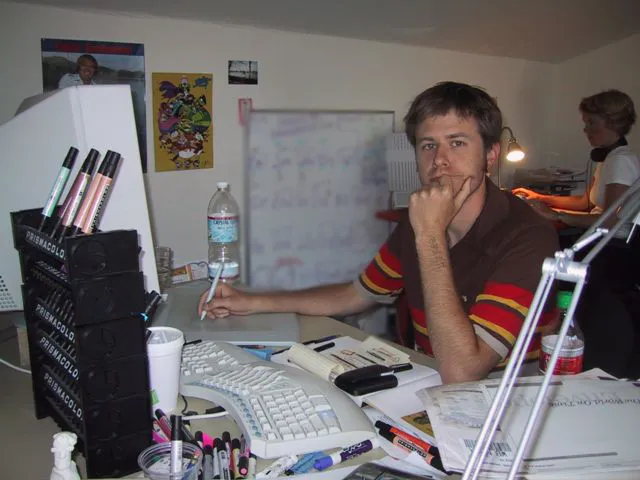 Photo Credit: James Spafford // Double Fine Productions Photo Credit: James Spafford // Double Fine Productions "You would drive into the office, and like, pull up right next to somebody's desk and turn your car off," says Nathan "Bagel" Stapley, a senior concept artist for Double Fine. "There was no heat, either," says senior animator Ray Crook. "And so, in the wintertime, we would just hang up big sheets of plastic and had these little space heaters that would blow the circuits if you had more than, like, three of them going." The neighborhood, at the time, wasn't always safe, either. Writing in a 2015 postmortem for Gamasutra, Caroline Esmurdoc, Psychonauts' executive producer, described the office as what "started as punk-rock charm soon became depressing, disgusting, and dangerous." "One night, a woman from the transient hotel next door jumped out a fifth floor window and landed on our roof, breaking her leg and knocking a hole in our ceiling," Esmurdoc wrote. "Another day, there was a dead body in the doorway across the street, apparently the victim of an overdose." They weren't ideal – or perhaps even always legal – working conditions, but with the bad is also the good. Talking to developers that were there at the time, there's an almost garage-band quality to the early days of Double Fine. They threw parties in the office, decorated the walls with interesting art, and overall enjoyed the company of their coworkers. For a little while, Schafer even made and painted every employee's desk. "That seemed like a cool startup thing to do," he says. Predictably, the interview process at Double Fine was also atypical. Lead programmer Kee Chi says that when he interviewed with the company, he talked about Zelda for an hour rather than answering any technical programming questions. Instead of going through the process of talking to recruiters and human resources, Levi Ryken, now a senior artist with Double Fine, had to speak to every single person at the company – to get hired as an intern. "Obviously, these things are all nicer to think about from a distance," Chi says. "And now that we have functioning toilets, we can look at it [like], 'Ah, remember the time when things were like that?' But it's also a time when all of us got to know each other and parts of the game came together. There was a lot of DIY feeling at the old office, that the new offices [don't] quite have. But it also could either be just fond memories of different times or the carbon monoxide poisoning we got at the time. It's one of those things." Coincidentally, Psychonauts was initially being developed for Microsoft, which was getting ready to release the original Xbox around the same time as Double Fine's founding. While pitching the game, Schafer gave a talk at the annual Game Developers Conference about character design. It caught the ear of Ed Fries, then vice president of game publishing at Microsoft, who signed the game. At the time, Microsoft handed out ping pong balls with the Xbox logo on it, which Fries gave Schafer when they first met. Two decades later, Schafer says he had the ball sitting on his desk when he signed the paperwork for Microsoft's acquisition of Double Fine in 2019. "I had it on a table in a little stand like a little ceremonial thing to bring the whole thing full circle," he says. Inspired by the team's love of games such as Rayman and Super Mario 64, Psychonauts is a 3D platformer telling the story of Razputin "Raz" Aquato, a 10-year-old psychic in attendance at Whispering Rock Psychic Summer Camp. Raz goes into the minds of various people, confronting their problems and helping them work through their issues. Psychonauts was also made to harken back to the team's memories of summer camp, being kids exploring the woods and stumbling upon unexpected discoveries. "We had those childhoods," Schafer says. "Back when you're, like, free-range kids, where you'd just wander into really dangerous locations and explore. A lot of those memories got into the first game." 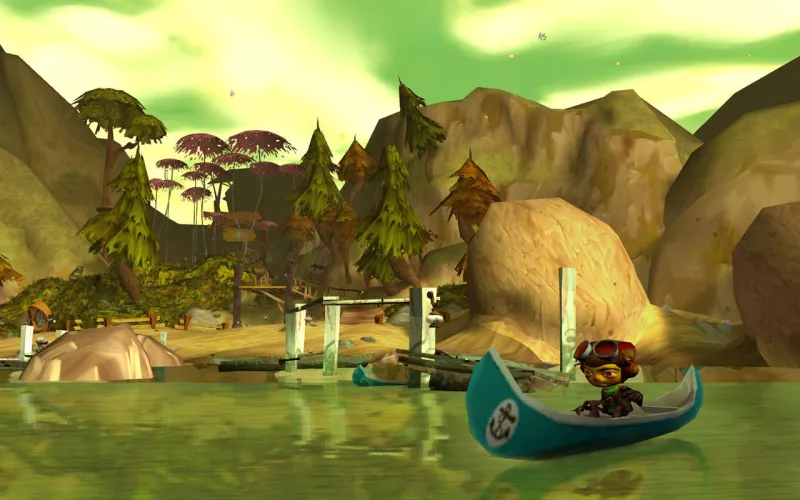 But Psychonauts' development was brutal, and the developers we talked to quickly brought up how hard the company crunched while making the game. There were a few reasons why. For one, Schafer, who wrote and directed the game, had spent the last decade making point-and-click adventure games at LucasArts; he had no experience with 3D platformers. Neither did numerous members of the team. Compounding issues, this was at a time when developers typically made their own engines in-house from scratch. And this was all on top of the fact that Double Fine was a new studio and it had to grow, staff up, and learn how to be a real company. It had to invent all its development pipelines and processes. There was a lot to be done, forcing the team to crunch continuously. "Back then, you guys were rolling your own engine with a small studio on a new IP with a brand-new team in a f---ing automotive garage," says principal artist Lee Petty. "So yeah, that's gonna be hard." "All processes that you would think a more mature [studio] would have then, we were just all figuring it out," Chi says. "But I also think this naive optimism that we had in making the game also made it so that we could make the crazy game that we did [in] Psychonauts, even though it came with a lot of growing pains [because] we made it in the way that we did." 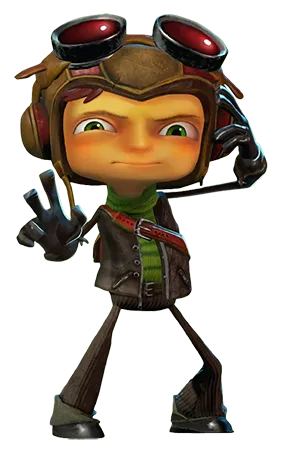 Psychonauts was in development for around five years. In that time, Double Fine learned how to operate as a team and make the game it wanted to make. But it came with some high costs. There was, of course, the crunch. "It was terrible," Crook says. But also, Microsoft was going through its own internal changes. In January 2004, Fries left the company. Around the same time, Microsoft was beginning its transition to the Xbox 360 in preparation for its November 2005 release. This halted funding for original Xbox games planned to launch after 2004. Expensive and behind schedule, new management within Microsoft opted to cancel Psychonauts – even though, by this point, Double Fine felt it was finally making real progress. "In February 2004, at what seemed to be our peak productivity, a time when we felt most confident about shipping on schedule, Microsoft decided to discontinue its development of Psychonauts," Esmurdoc wrote in her postmortem. "Microsoft had funded years of mistakes, course corrections, and learning curves, but it drew the line at underwriting the remaining game development now that Double Fine was finally on track. When Ed Fries departed Microsoft, the new management seemed to think that we were expensive and late. The assessment was accurate, though it did not reflect the progress we were finally making toward shipping the game and recovering the development investment." 2004 was a rough year for Double Fine – one it nearly didn't survive. In multiple past interviews, Schafer has even admitted to telling his team Double Fine was shutting down, and that the next paycheck would be the final one. Luckily, however, a loan from SimCity creator Will Wright was able to keep the company afloat before a late-stage deal with Majesco saved both the project and the studio. But despite all the hard work Double Fine put into getting it made, when Psychonauts came out, it was a commercial failure. It got great reviews, but no one was buying it. Psychonauts sold less than 100,000 copies in 2005. "It was one of those situations where if we'd known, like most games, if you really knew how hard they were going to be by the time they were done, you probably wouldn't have started any of them," Schafer jokes. But the lessons Double Fine learned on that first game would continue to shape the company for years to come – even if its following projects were far cries from summer camp.
|
| Razer Anzu Smart Glasses Review | Smart Enough For The Price Tag? Posted: 05 Jul 2021 01:00 PM PDT I've never been into the "smart glasses" thing. I've seen them, and been slightly intrigued by them, but I never saw them as something to be super excited about. Then I sat down and reviewed the Razer Anzu and now I understand their incredible potential. With Bluetooth capability, microphone, and anti-blue light protection, Razer's newest foray into the far reaches of the gaming-verse is not too shabby. Surprisingly, no RGBs, either. How Do They Look and Feel? The term "smart glasses" pertains to technological capabilities. Smart glasses allow users to connect to outside hardware, respond to certain commands, and have added app functionality. This tech is nothing new, companies like Amazon and Bose have released their own versions, so how does Razer compare? Pretty nicely, as long as you manage expectations. The Razer Anzu glasses look like any normal pair of thick-framed glasses. You can choose from a round frame version and a more traditional rectangle design, both of which come in a variety of different sizes to ensure the right fit. The Anzu looks similar to the Amazon Frames, where the chunky arms are used to house the smart tech. One pair of Anzus comes with two different charging ports, one for each arm of the frame. They're a little bigger than I expected, but surprisingly not as weighty as they look, which is good for long-term comfort.  If they fit my big dome piece, they'll fit yours. If they fit my big dome piece, they'll fit yours. How To Set Them Up When setting up the glasses and the touch controls, there are two things to consider. You can pair the glasses with a phone or gaming computer, and you can adjust certain settings with the Razer app. Pairing the glasses with a device is easy. The Bluetooth pairs like anything else as long as you make sure you open the arms to activate Pairing mode. To disconnect them from a tethered device, simply close the arms. If you don't want to do that and are super attached to the Razer app, you could sync up to Bluetooth that way, but I found it to be more complicated than necessarily worth it. My glasses would sometimes fail to pair correctly through the app, so I just paired my glasses through my computer and smartphone settings and I would recommend anyone that has a pair to do the same. Functionality I didn't love the Anzus' functionality. The Amazon Frames' arms have raised buttons that allow users to tinker with certain settings, like volume. The Razer Anzu does not have anything like this. Instead, they utilize a small touch panel, which isn't the best in terms of functional control over the settings and limiting in terms of accessibility. I'm assuming this was designed with a futuristic aesthetic in mind, as well as a way to differ from the competition, but that choice made me feel less in control over the settings. I struggle with MS, and I don't have any feeling in my fingers, so touch-reliant controls are a little tricky. The fact that these controls are on my face (and therefore out of sight) exacerbated the issue. Even worse, the Anzu touch controls don't always work the way they are supposed to. The mobile app has one great feature, a tutorial that helps you learn the different ways to use the Anzus, including gesture commands, info on the touch panels, and how to use certain features. This feature helped me see the different ways I could communicate with the glasses and make them do what I needed them to do, such as making a call to someone or giving the little AI assistant a command to look something up for me. One word of caution, however, is that you shouldn't listen to the directions when it says to "tap." The controls, at least in my experience, do not respond to a casual touch as represented in the tutorial, instead, a firm press is required. So when it tells you to double "tap" the panel, know that their definition of "tap" is a little different than most and that a quick press won't get the job done. How Do They Sound? Through the Razer app, there are a couple different EQ presets. These are basic presets, and nothing special, especially when listening to music or gaming. The Treble Boost helped a lot when listening to music, but I feel that the quality could use a little improvement. That said, when I was listening to the Game Informer Show (plug, plug, plug), the different settings impacted the audio quality much more than they did with more complicated sound experiences in terms of making the sound more clear and with a little more impact (though still lacking in anything bass-related). I noticed a small sound bleed, as well. Below the 50 percent marker, I had no issue, even when gaming. Anything above that, however, the people in my Discord or Zoom meeting mentioned that they could hear some audio leaking on their side. I played a few different games using the glasses; from Destiny 2 to Dragon Age to Dead by Daylight, and I got the frantic voice chat of my team to come through. The audio sounded alright. I don't expect the high-level quality of over-the-ear headphones, so the quality felt appropriate.  How is the Game Mode? Anzu's Game Mode produces low-latency audio. According to Razer, the Anzu glasses utilize an "industry-leading 60ms" Bluetooth connection to ensure quality performance. I used these for different games to "stress test" at different levels. Without Game Mode active, I noticed a definite lag in the audio. With Game Mode on, however, there was a noticeable difference, but I still heard a little bit of a delay regardless, which goes against the claims that the audio experience will remain "stutter-free." Blue Light Compatible As a games writer, I am always in front of a computer. When I'm not at work, I'm still at that same computer playing games. It's a vicious cycle of screentime, but totally worth it. This all means that blue light protection is important to me. Over the years, blue-light blocking glasses have become all the rage, and for good reason! Whether you're on a computer all of the time for work, or like to chill out in front of a gaming PC or console, the blue light in everyday screens can really do a number on our eyes. Migraines, vision impairment distortion, sleep disruption – even seizures, the list of harmful side effects of the screens in our lives goes on and on. As someone who experiences seizures from time to time, I always ensure my eyewear has blue light technology. The Anzu glasses come with a 35 percent filter, which sounds low but is actually really good. For those who want these for the additional blue light protection but are worried they are too clunky for your prescription glasses, Razer promises that the Anzu is compatible with every prescription. That means you can take a pair to your eye doctor to get corrective lenses put in. You can also go to this link to get 15 percent off lenses through Lensable. The polarized lenses also offer 99 percent UVA/UVB protection, an added attachment that comes in the box for those on the go. That level of protection also aids against eye strain. How is the Battery? Battery life in the Razer Anzu is the best out of any smart glasses we've tested so far, boasting anywhere between four to five hours of undisrupted use. The lowest time I clocked when wearing these with continuous use was just shy of four hours, and that was with constantly playing with the settings, connecting and reconnecting, and various stress tests – without pause – with different audio sources. Click image thumbnails to view larger version 
The Good, the Bad, the "Are They Worth It?" Overall, I think that this is a solid piece of hardware. Though I wish they would reconsider the touch paneling and would fine-tune the audio range, I have been really enjoying my time with a pair of Anzus. They are comfortable, I like the different size options, and they work how I expected them to work. If Razer can optimize the touch controls and the gesture settings, and make the Gaming Mode a little more viable, I think this could be a tough piece of tech to beat. If interested, you can try out a pair for yourself right here for $199.99. Oh, and those dope RGBs, man. Come on, you're Razer, how can you not have that as an option?
|
| Behind The Animations & Cutscenes in Marvel's Guardians Of The Galaxy Game – Exclusive Interview Posted: 05 Jul 2021 12:00 PM PDT 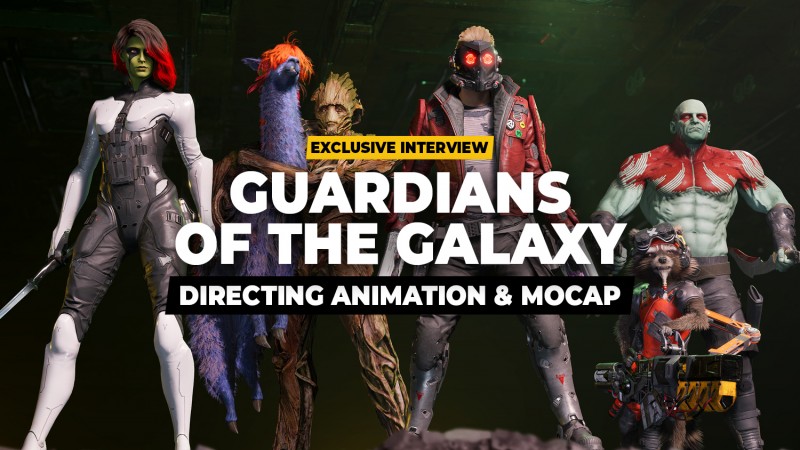 Click to watch embedded media Click to watch embedded media Marvel's Guardians of the Galaxy is the latest game to grace our cover, and in this exclusive interview we sat down with the game's Animation Director, Darryl Purdy, to learn more about gameplay animations, directing cutscenes in the game, and overcoming challenges presented by motion capture. If you're interested in learning more about Marvel's Guardians of the Galaxy after watching this video, be sure to read our 12-page cover story. You can learn all about the game's lesser-known characters in this issue, like Lady Hellbender in this brief snippet: Although Thanos' name is thrown around liberally by Eidos-Montréal, he's only being referenced in the backstory at this point. The focus for the moment is on just one villain: Lady Hellbender. She made her debut in 2016 within the first issue of Frank Cho and Greg Pak's Totally Awesome Hulk, and immediately became known as the "monster queen" from her desire to collect rare beasts for her sanctuary on Seknarf Nine. We don't know much about her origin story or motivations within Eidos-Montréal's game, but she clearly still has an eye for rare monsters, and the Guardians may have just handed her the prize of her collection. In the comics, her real name is Marguerite Hellbender. When she makes appearances, she always shows us she has superhuman strength, is proficient with a sword, and will do anything to get the creatures of her desire.Over the course of the next week, Game Informer will publish a heap of exclusive behind-the-scenes interviews with key members of Eidos-Montréal about how they're bringing this team of misfits to life. While you wait, be sure to check out our Marvel's Guardians of the Galaxy coverage hub, where you'll find articles, podcasts, and videos all about the game. Don't want to hear anything else about the game before it releases? Well, you won't have to wait long since it launches on October 26, 2021.
|
| OlliOlli World Feels Like A Fresh Start For The Series Posted: 05 Jul 2021 11:00 AM PDT There tends to be two schools of gameplay when it comes to skateboarding games: the arcadieness of the Tony Hawk series and its ilk, and the more technically-focused simulations of the Skate series and the games it inspired. While I'm sure there are plenty of people who enjoy both, I tend to see it as one or the other; you either prefer the over-the-topness of impossible combos in Tony Hawk, or challenging yourself with next-to-real lines in Skate. I much prefer the former. For two games now, the OlliOlli series has fallen more in-line with the latter, being a 2D take on the simulation skateboarding genre. And for what it's worth, this has worked outstandingly for developer Roll7, which not only received acclaim for its action sports games, but even won a prestigious BAFTA in 2015 for the first OlliOlli. But if you're like me, playing OlliOlli and its sequel can feel inscrutable. Even in their earliest sections, aside from teaching you the basics of controls, the games often feel as though they are just cutting you loose to figure it out yourself. If that's a struggle, too bad, so sad. You will be punished for your mistakes. Roll7 isn't blind to this fact. "OlliOlli 2, if you miss a landing, we punish you three different ways," Roll7 CCO John Ribbins tells Game Informer. "You lose your speed, you get a crappy animation, and you lose your score. I think we just thought, 'That's so harsh.'" The next game in the OlliOlli series, OlliOlli World, hopes to lower the barrier to entry for the series. While the developer says it isn't necessarily removing the skill ceiling – fans of the first two games will still find deep systems and tricks to perfect – simply booting the game up and having fun has been made far more approachable in World. Click here to watch embedded mediaWe recently had a chance to go hands-on with OlliOlli World and put this to the test. For the most part, Roll7 is spot-on. Within minutes, I was able to begin building my combos, implementing new tricks and mechanics, and I didn't feel as if the game was taking every chance it could to punish me. After a few hours with the game, I was besting personal high-scores and pulling off more and more complex trick lines as my knowledge of levels grew. I don't doubt this will initially turn off some of the more hardcore OlliOlli fans, but for me, who never really clicked with the first two games, I felt it was immediately satisfying to grasp what the game was asking of me and far more fun and interesting to pull of cool tricks instead of banging my head against a near-vertical skill curve. "While we don't want to get rid of that, we want to provide players with more space in the game to actually just cruise around and enjoy feeling a bit more skillful," says Roll7 co-CEO Simon Bennett. "Like a badass," Ribbins quickly follows up. OlliOlli World's visual palette has also received a complete makeover. Where its predecessors used a 2D sprite-based look, World goes for a cel-shaded, cartoony aesthetic that's altogether more interesting and fun. The game's different levels also benefit from this overhaul, featuring a variety of different backdrops to try and catch a glimpse of as you skate by. 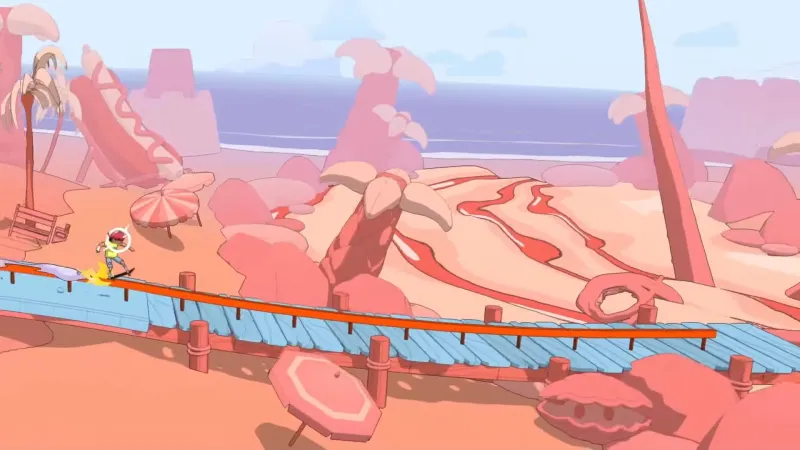 The last major change World brings to the series is a story. The game tells the tale of an island called Radlandia, which is governed by, as Ribbins puts it, "skate gods who are masters of the various elements of skateboarding." As the player character, you'll travel around Radlandia with a group of locals on a road trip – inspired in part by old skate videos and the team's own experiences – trying to master the gods' different skills. It's a goofy premise, but one that conveniently gives meaning behind the game's level design. Which, rather than just be a series of rails and stairs, incentives using the geometry to explore the different areas of Radlandia. Instead of one linear track to skate down, World will have numerous different paths within a level to explore. Rewards, side-quests, and alternative paths can all be found through exploration. While I didn't get too much time with the game's overall story (which, if I had to guess, is light at best), it didn't do much for me. If anything, I found each secondary character to be a grating caricature of different skate archetypes; cartoon versions of what's "cool" you might find on the bottom of a Wal-Mart skateboard deck. Luckily, it's easy to skip the game's dialogue. Roll7 hasn't announced a definitive release date yet for OlliOlli World, but it's expected to be released in the winter. Based on my time with the game, I'm excited to play more. At a basic level, it's a good-feeling game, but I'm also interested in seeing how its approachableness lends itself to the harder levels and how my own skillsets adapt to that skill curve. OlliOlli World will be released on PlayStation 5, Xbox Series X/S, PlayStation 4, Xbox One, Switch, PC.
|
| Griftlands Review – Great Friends In Low Places Posted: 05 Jul 2021 09:00 AM PDT Publisher: Klei Entertainment Developer: Klei Entertainment Release: Reviewed on: Xbox Series X/S Also on: PlayStation 4, Xbox One, Switch, PC Griftlands is a deck building game set on a cutthroat alien planet where conflicts require either a sharp dagger or sharper wit. Your tools to survive are shuffled into decks of cards that grow and evolve through the course of the adventure. Klei Entertainment's card battler sounds similar to games like Slay the Spire, but the differentiator is an interconnected world full of characters and factions where your actions and relationships actually matter. Griftlands presents a mostly satisfying narrative while scratching my itch for complex deck building roguelikes. The bulk of Griftlands' action revolves around card slinging during heated negotiations and battles. However, the combat and negotiation systems both have bespoke decks and mechanics. Battles are straight forward physical fights where you use attack, defense, and augmentation cards to defeat the opposing force. These augmentation cards do everything from apply damage over time to increase the power of other attacks and they do a great job adding strategic depth to the action. Sentient enemies and allies have panic points and surrender once their health drops below a certain threshold. This clever system gives you a powerful and intriguing choice to spare or execute your foes, though accidents happen, and people can die regardless of your intentions. Killing an enemy rewards you with cards to add to your deck, but their death makes the public aware of your pension for violence and can turn a victim's friend into an enemy. I enjoyed maintaining the delicate balance of keeping foes alive while dispatching of their cohorts to keep my character's standing in the world as pristine as possible. Adding this combat puzzle to encounters wonderfully extends agency into a system easily boiled down to kill or be killed and helped add additional stakes to each encounter. Click image thumbnails to view larger version 
Negotiations, on the other hand, are my favorite part of the game. I love seeing my conversations represented through game mechanics rather than the typical dialog tree. Additionally, I appreciate being able to navigate conflicts without always resorting to violent tactics. These debates are triggered when trying to get information, pushing for a few more shills on a completed job, or to demoralize an opponent before a real fight. Your goal is to reduce the resolve of your opponent's core argument. Side arguments have various effects on the discussion, giving benefits to yourself or hindering the opponent. These additional arguments stand separate from your core argument and must be defended as if they were allies in battle. Failing a negotiation doesn't end the game, so negotiations present a complex, fun, and low-risk solution to some problems. Losing a negotiation may lead to a physical confrontation, but talking things through can avoid some confrontations or provide buffs during street fights, so it's usually worth a shot. I found it a little overwhelming at first to learn a second set of card mechanics, but ultimately I found the flavor and execution of the negotiation system to be excellent. Griftlands' three distinct campaigns are full of meaningful content, each following a unique character in different areas of the harsh continent of Havaria. Sal seeks revenge against someone who sold her into indentured labor in Murder Bay. Rook is a former military agent specializing in espionage who works both sides of the conflict in the Grout Bog – just like he works his trademark lucky coin. Smith, the black sheep of a wealthy family, aims to collect an inheritance he was never promised by bolstering his fame despite his heelish personality. All three stories feel very different, but together paint a great picture of the factions, people, and struggles that tie the world together. Sal's narrative feels more urgent and dire than the others, while Smith's story is breezier and lets you revel in playing a self-absorbed jerk. Learning their differing styles of combat and negotiations is a joy. The entire cast is fun to pilot and each employs tactics in-line with their personalities. For instance, Smith uses his notoriety to do the heavy lifting in negotiations while his combat style is a mix of heavy drinking and self-harming pro wrestling moves. Discovering ways to exploit Rook's reliance on coin flipping manipulation and creating devastating negotiation combos was an absolute highlight of my time in the Griftlands. Click here to watch embedded mediaThe main story beats remain the same from one run to the next but the jobs you take each day, and the choices along the way, create a new adventure each time. You may end up on the opposite side of the final conflict or find yourself facing down allies you befriended earlier in the run. These choices make each run through Griftlands rewarding and help sell the procedurally generated story moments. All of the named denizens of Havaria have their own factions, places they frequent, and styles of negotiation and battling. If you are in their good graces, they may even jump in and give you a hand during conflicts. I spent a few shills grabbing a drink with a character one night and then they saved my butt the next day when I got in a jam. It's important to make friends along the way and hard to survive without a few on your side. This leads to a minor gripe: there aren't many reasons to want characters to dislike you. In a game where morality and relationships are at the core of your interactions with a harsh, dangerous world, the fact that you can't use negative emotions to your benefit in some way feels like a missed opportunity to me. Griftlands is an ambitious package. Not only does it combine two different compelling deck building systems into one game, but it's attempt at relationship building feels like a small-scale version of what I loved about Mass Effect. Best of all, it pulls it off. Griftlands leverages the strengths of card-based roguelikes, delivering a different experience with each adventure, providing various deck archetypes for each playable character, and every in-game day brings new objectives to keep the experience fresh. The Griftlands may be an unforgiving, harsh place to live, but it's a world I'd like to keep visiting. Score: 8.75Summary: Klei's fun and challenging card mechanics are backed up by great characters and elaborate worldbuilding. Concept: Survive in a harsh land by talking and fighting your way out of challenging situations with decks of cards Graphics: Griftlands features beautiful illustrations making each location and character memorable and distinct Sound: Synth beats and spaghetti western-inspired tracks fill the soundtrack with music tailored well to each grifter Playability: Winning isn't easy, and the card systems are full of complexities, but learning their intricacies is very satisfying Entertainment: Griftlands provides drama, laughs, and fun strategy that's a great twist on the genre, adding more character depth and lore than the usual deck-builder Replay: High |
| Best Cozy Games To Play On Nintendo Switch Posted: 05 Jul 2021 07:02 AM PDT Sometimes, you just need to sit down and enjoy some cozy games to unwind. Whether it's taking a few moments to yourself after a hard day, or bundling up in a blanket burrito with a hot beverage and your Nintendo Switch - self-care is self-love. For those looking for a cozy game to play on their Nintendo Switch, we've got a few picks for you to consider. Best cozy games to play on Nintendo SwitchThe obvious addition to this list is Animal Crossing: New Horizons, so I'm going to leave that as an honorable mention to make room for other titles so that they can get some spotlight. So, without further ado, here are some cozy games to get on your Switch to get crackin' on some relaxation.  |
| You are subscribed to email updates from Game Informer. To stop receiving these emails, you may unsubscribe now. | Email delivery powered by Google |
| Google, 1600 Amphitheatre Parkway, Mountain View, CA 94043, United States | |

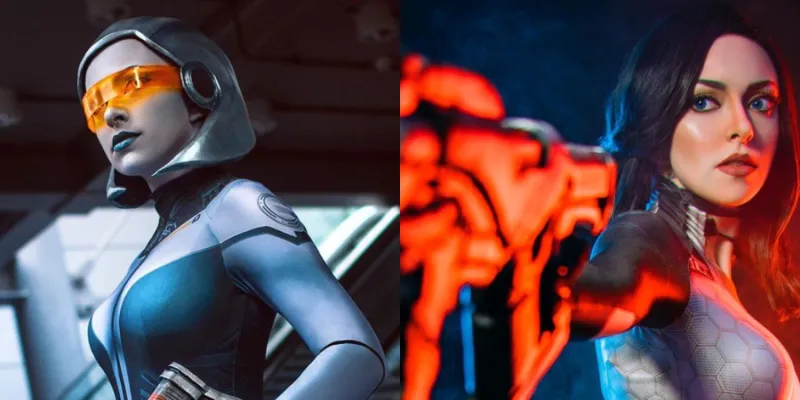
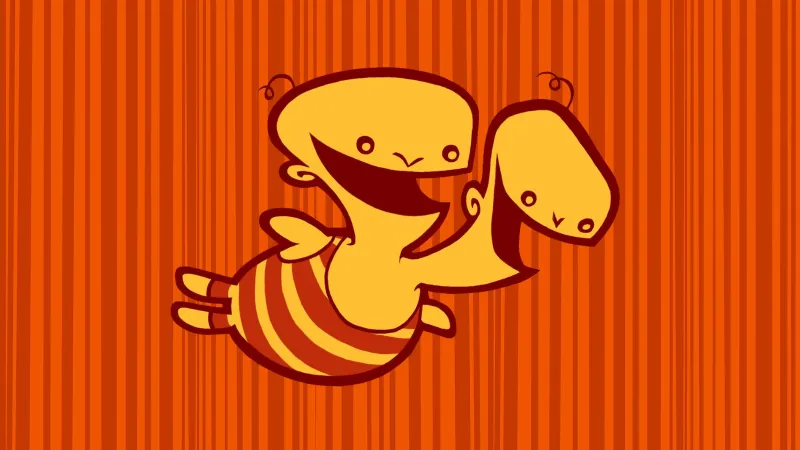
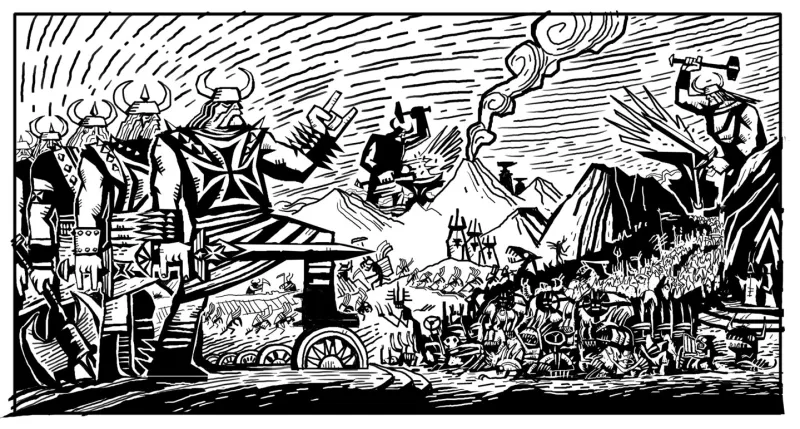
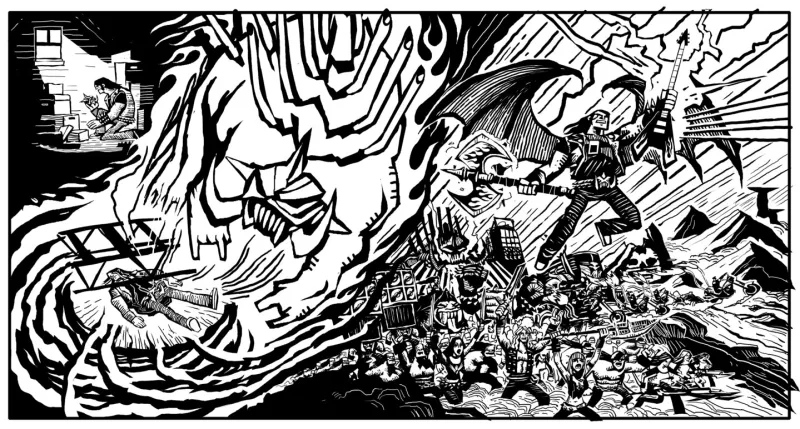
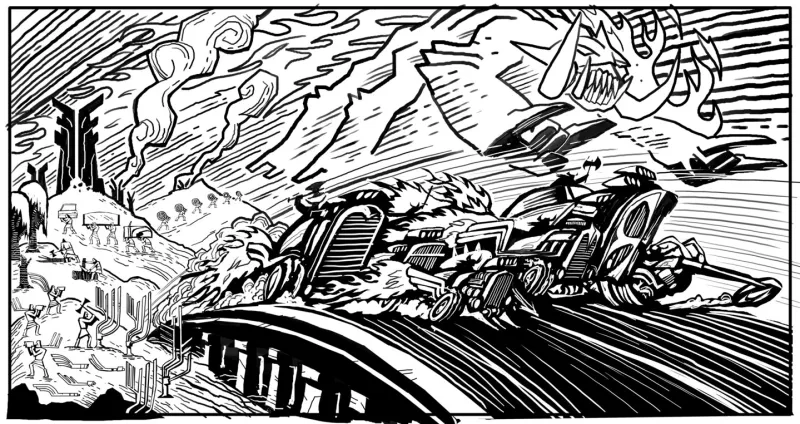
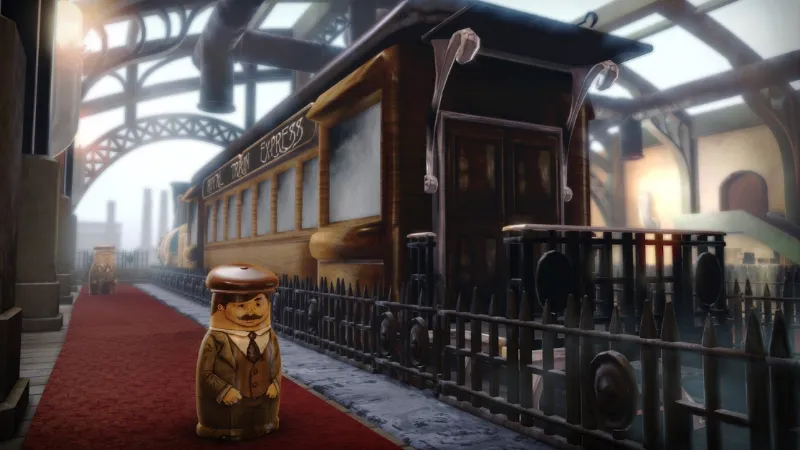
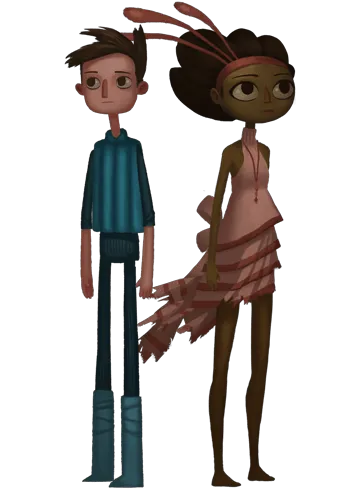
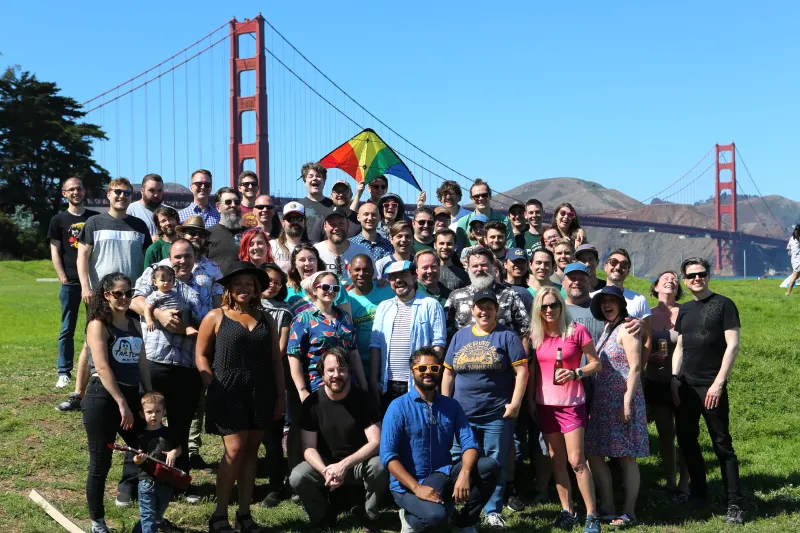 Double Fine summer picnic (2019)
Double Fine summer picnic (2019) 
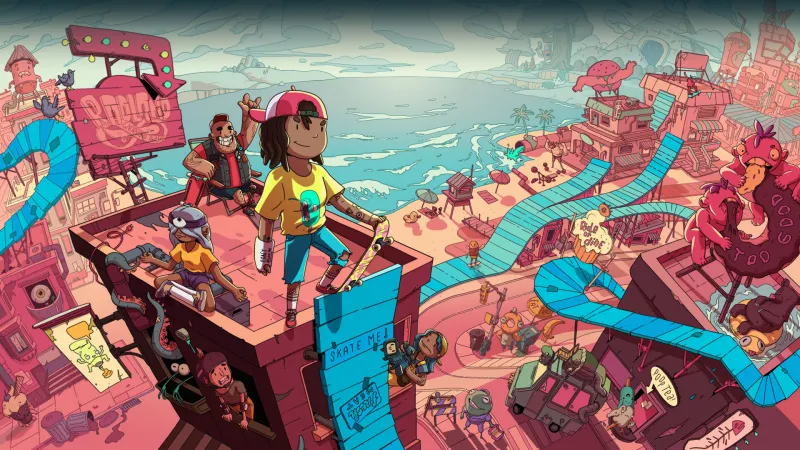
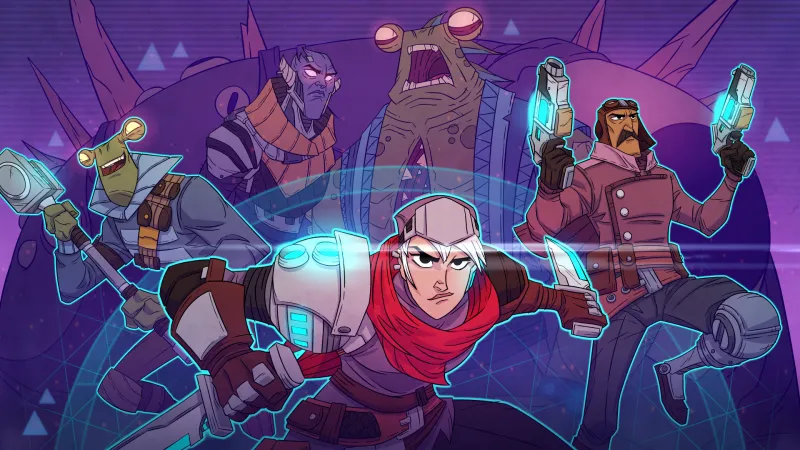


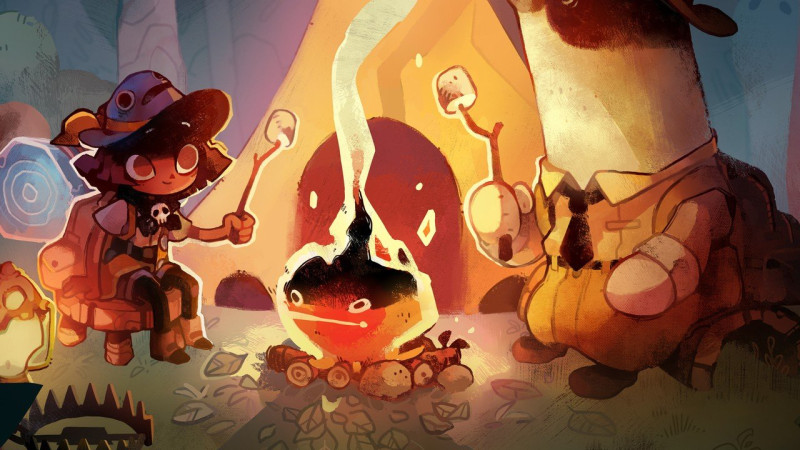
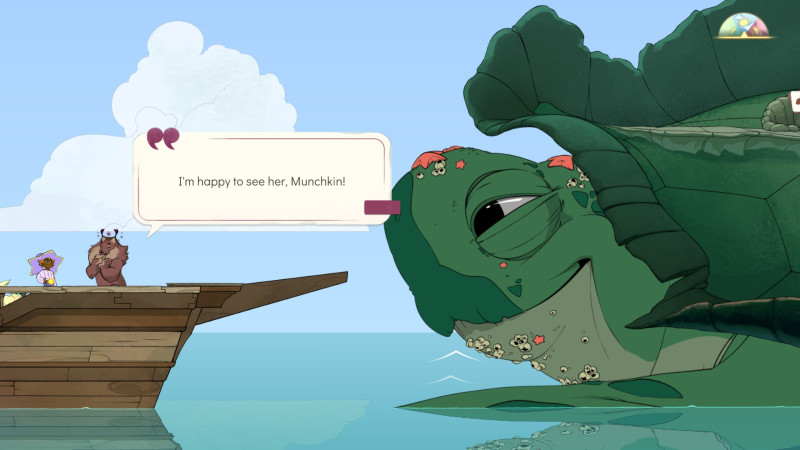
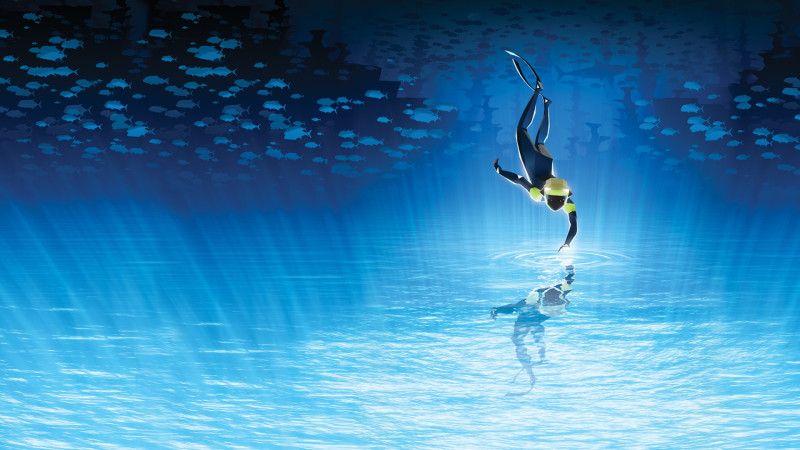
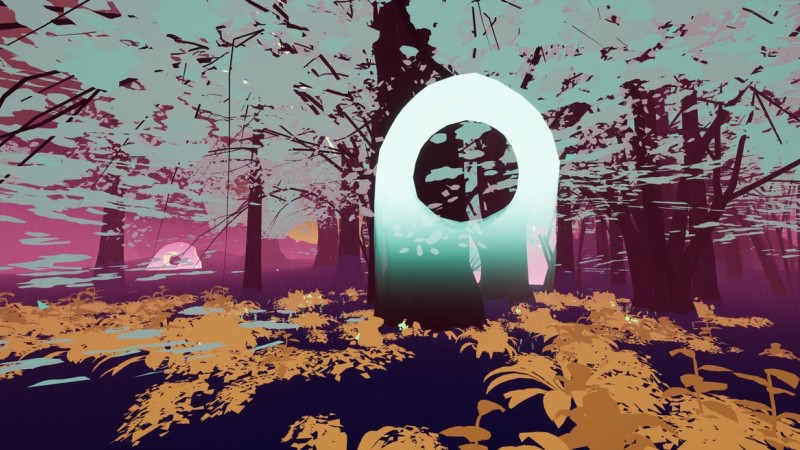
No comments:
Post a Comment